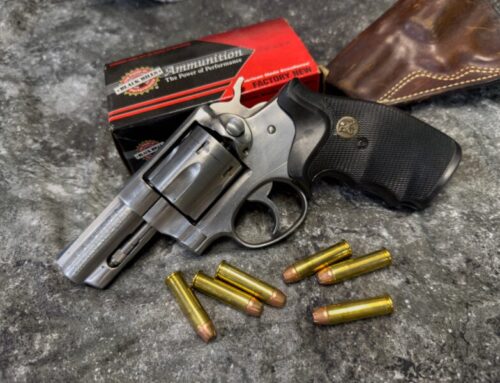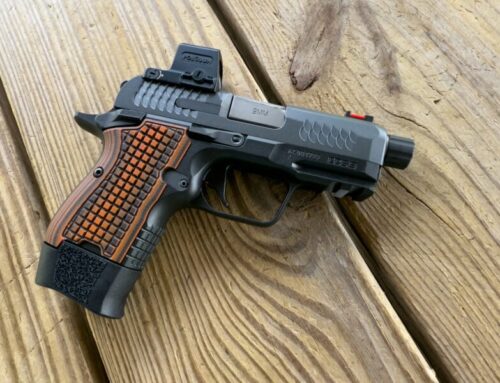
Here’s a slightly “geared up” Daniel Defense DDM4v5 300 Blackout.
Some phrases are just fightin’ words.
“That’s MY horse!”
“That’s MY daughter!”
“I love the 300 Blackout!”
For some reason, virtually any gunny discussion about the 300 AAC Blackout cartridge quickly devolves into a typing wind sprint where the winner itemizes more reasons why the 300 Blackout is not as good as (fill in your favorite cartridge here.)
Due to the unique performance characteristics and its wide range of velocity an projectile weight combinations, it gets poked in the eye from both ends of the ballistic spectrum.
The high speed supersonic crowd gets bent out of shape because, in their words, the 300 Blackout…
“Doesn’t have the same energy or reliability as the 7.62×39 AK-47 round.”
“Doesn’t have the ‘reach out and touch someone’ range of the 6.8 SPC.”
“Ammo is way more expensive than the .223 Remington / 5.56mm!“
The rumble and bumble subsonic cartridge fans fans claim…
“Why not use a pistol or MP-5?”
“Subsonic rounds are unreliable unless you use a silencer.”
“Ammo is way more expensive than .223 Remington / 5.56mm!”
This reaction is understandable. We all know that if you encounter someone who’s wrong on the internet, you have to rectify the situation immediately, right?

Subsonic ammo, like these 220 grain Sierra MatchKings, shot surprisingly well.
As with most debates, there are a lot of elements of truth in all of these statements. But I don’t really care. That’s because, for me, whether the 300 Blackout is interesting or not isn’t a binary question. It doesn’t have to be better than (fill in the blank.) I like the fact that it’s a different option with unique capabilities. In fairness, I might be more biased in favor because I’m a reloading enthusiast, and the 300 Blackout is a reloaders dream.
What’s 300 AAC Blackout?
The simple explanation is that the cartridge offers 30 caliber performance and viable subsonic options from a standard 5.56mm AR platform. A 30 caliber barrel swap is required, but other than that, the bolt, carrier, receivers and magazines are compatible. Without delving into the debate here, the idea is to provide improved terminal performance, especially from short barreled rifle platforms. The subsonic option is interesting as a 300 Blackout can launch a 208 to 245 grain projectile in the 1,000 feet per second velocity range. When used with a suppressor, the sound level is very, very quiet. Switching a 300 Blackout rifle from supersonic to subsonic performance involves no more than a magazine change. We’ll get into more detail on the wide variety of cartridge options later in this article series.
One big drawback to shooting 300 Blackout is ammo cost and availability. That pesky supply / demand thing means there is much less manufactured, so it’s expensive and harder to find. If you shoot 300 Blackout it’s in your best interest to reload your own ammunition.
The Daniel Defense DDM4v5 300 AC Blackout
You might say Daniel Defense rifles are built from the parts up. The company started by making a simple part – a receiver mounted sling loop. You know, it’s that typical American success story. Some person out there has a better idea, they figure out how to make it, then sell it to the masses. In an oversimplified sense, that’s sort of how Daniel Defense rifles came to be. After the sling loop had started to sell, Marty Daniel figured he could also invent a better rail system for AR type rifles. Ultimately, he figured, why not build a whole rifle from the ground up using parts designed and manufactured mostly in house?
When it comes to rifles, ground up really refers to barrel out. One of the first big equipment investments at Daniel Defense was a cold hammer forging machine for making barrels in house. Cold hammer forging is kind of a cool process. You take a steel tube with a hole in it, insert a perfect 3D mirror image of the barrel interior and chamber (a mandrel), then pound the living crap out of the outside of the tube until the interior takes the form of the mandrel inside. The reason for all this pounding and noise is that the end result is a smoother and stronger finished product, and that leads to better accuracy and longer barrel life. No pain, no gain, right?
Let’s get back to the rifle at hand. The DDM4 series is infinitely configurable, so I’ll talk about the options I chose for this rifle here. Just be aware that you can build your own at the Daniel Defense website if you want to tweak options like trigger, chrome, iron sights, rail type, flash suppressor and more.
Let’s touch on some of the high points of this rifle, then we’ll talk about significant details. It’s well built for military-level reliability. Gas keys are staked, parts are mil-spec compatible and Daniel Defense pays attention to the little things that add up to long term performance under rough conditions.
Be sure to check out our latest book, The Rookie’s Guide to Guns and Shooting, Handgun Edition 2nd Edition 2014. It’s ON SALE now for a limited time!









Leave A Comment